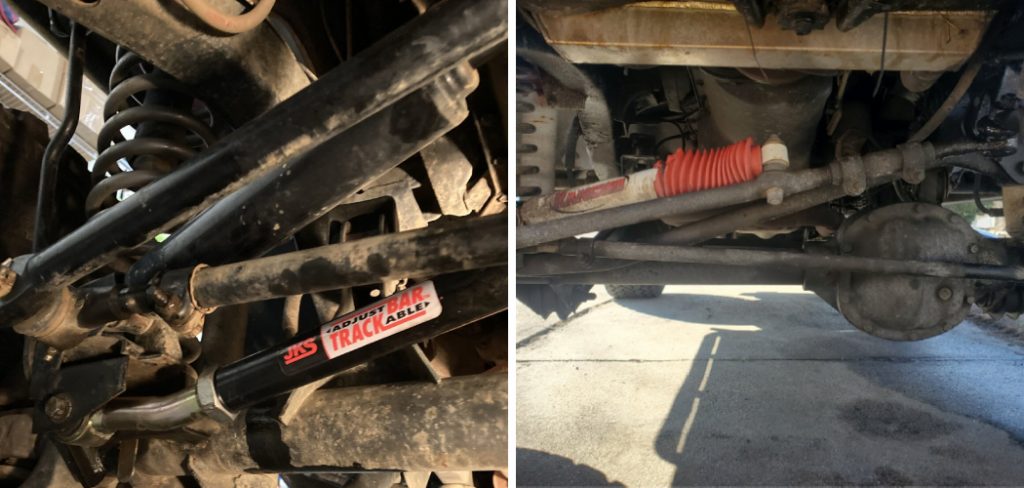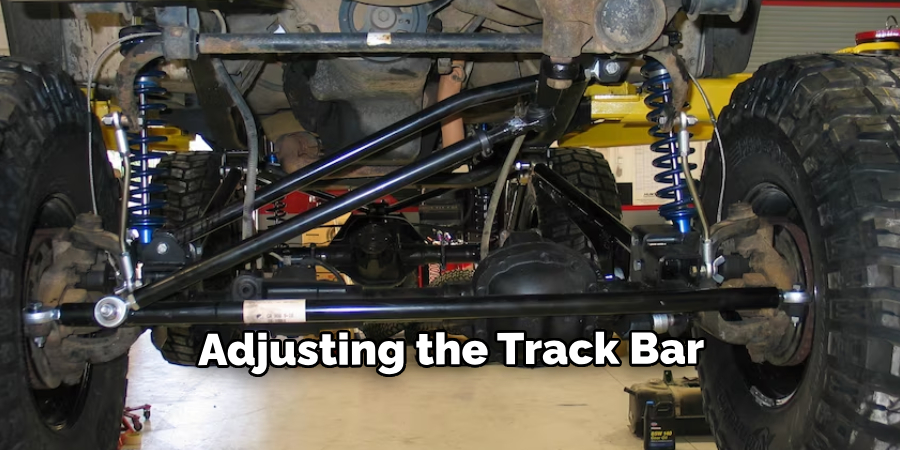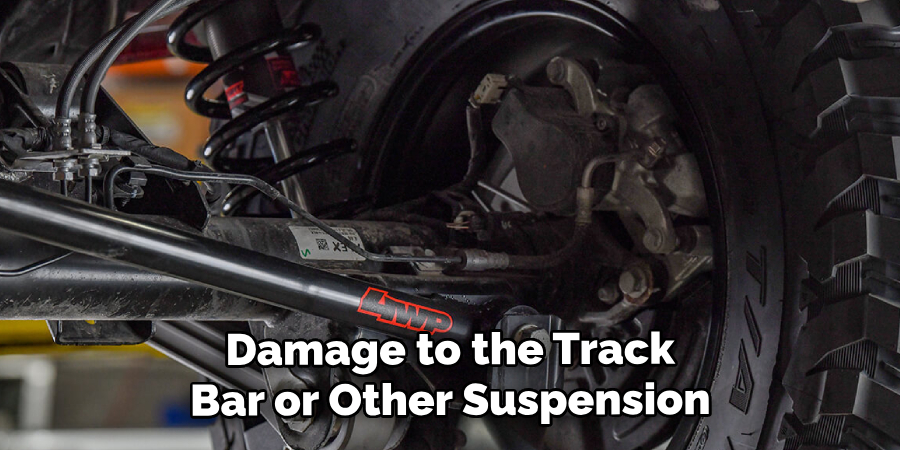Adjusting your track bar is a simple way to optimize your vehicle’s handling and performance, but many drivers don’t fully understand the ins and outs of this important component.

A track bar, also called a Panhard rod or track rod, is a crucial link in your vehicle’s rear suspension system that helps maintain proper alignment of the rear axle. By tuning your track bar, you can fine-tune how your rear wheels respond over bumps and turns.
In this blog post, we’ll take a deep dive into what exactly a track bar does, why adjusting it matters, and how to properly set it for your driving needs and conditions. By learning How to Adjust Track Bar, you can unlock your vehicle’s full handling potential and make the most out of every drive. Let’s get started with the basics of this oft-overlooked but highly impactful suspension part.
Why May You Want to Adjust Track Bar?
1 . To Correct Drifting
A track bar is an essential component of a vehicle’s suspension system. It connects the axle to the chassis and helps to keep the wheels in alignment while driving. Without proper adjustment, your car may start drifting, which means that it will pull or veer towards one side.
2 . To Enhance Stability
Another reason why you may want to adjust the track bar is to improve the stability of your vehicle. A properly adjusted track bar will help to increase the handling and control of your car, especially when taking sharp turns or driving at high speeds.
3 . To Improve Tire Wear
Improperly adjusted track bars can cause uneven tire wear, which can lead to costly replacements and potentially dangerous situations on the road. By adjusting the track bar, you can ensure that your tires wear evenly, prolonging their lifespan and keeping you safe while driving.
4 . To Prevent Steering Issues

When a track bar is not correctly adjusted, it can cause steering issues such as a loose or unresponsive steering wheel. This can make it difficult to control your car and can potentially be dangerous in emergencies. Adjusting the track bar can help prevent these steering issues and keep you in control while driving.
5 . To Maintain Suspension System
The track bar is an integral part of a vehicle’s suspension system, and regular adjustment is necessary to maintain its proper function. By adjusting the track bar, you are also ensuring that all other components of your suspension system are working together efficiently, improving the overall performance of your vehicle.
6 . To Accommodate Vehicle Modifications
If you have made modifications to your vehicle, such as lifting or lowering it, adjusting the track bar may be necessary to maintain proper alignment and handling. These modifications can affect the positioning of the track bar and require adjustment for optimal performance.
How to Adjust Track Bar in 5 Easy Steps
Step 1: Understand the Function of a Track Bar
Before we dive into how to adjust a track bar, it’s important to understand what it is and its function in your vehicle’s suspension system. A track bar (also known as a Panhard bar or lateral link) is a component that connects the axle housing to the chassis frame. Its purpose is to keep the axle centered under the vehicle, ensuring stability and preventing it from shifting from side to side.
Step 2: Check for Excessive Wear or Damage
Before attempting to adjust your track bar, you should inspect it for any signs of excessive wear or damage. Look for cracks, bends, or worn-out bushings. If you notice any issues, it’s best to replace the track bar before attempting to make any adjustments.
Step 3: Get the Right Tools

To properly adjust your track bar, you will need a few basic tools including a wrench or socket set, a jack and jack stands for lifting and supporting your vehicle, and a tape measure for precise measurements. It’s also helpful to have an assistant to help with the adjustment process.
Step 4: Adjust the Track Bar
To adjust the track bar, start by lifting your vehicle with a jack and supporting it securely with jack stands. Then, loosen the bolts that secure the track bar to both the axle housing and chassis frame using your wrench or socket set.
Next, have your assistant help you center the axle under the vehicle by pushing on one side while you measure from the center of the axle to a fixed point on the frame. This measurement should be equal on both sides for proper alignment. If it’s not, adjust the track bar by turning it in or out until the measurements are equal.
Step 5: Secure and Test
Once you have made your adjustments and achieved equal measurements, re-tighten all bolts securely. Lower your vehicle off the jack stands and take it for a test drive. Pay attention to how the vehicle handles and if there are any noticeable improvements in stability or handling. If you still notice issues, you may need to make further adjustments or have a professional mechanic take a look.
By following these five simple steps, you can easily adjust your track bar and improve the overall performance of your vehicle’s suspension system. Properly adjusted track bars can help prevent steering and handling issues, ensure a smoother ride, and extend the lifespan of other suspension components.
Some Extra Tips to Adjust Track Bar

1 . Do Not Adjust Track Bar While Vehicle is Loaded
It is important to make sure that the vehicle is not loaded while adjusting the track bar. This ensures that the vehicle’s weight does not interfere with the adjustment process and gives accurate results. Also, make sure that the vehicle is parked on a flat surface before attempting to adjust the track bar.
2. Use Proper Tools
Adjusting the track bar requires specific tools such as a wrench or socket set. Using improper tools can lead to incorrect adjustments and potentially damage the track bar or other components of the suspension system. It is always recommended to use the proper tools to ensure safe and accurate adjustments.
3. Check for Wear and Tear
Before adjusting the track bar, it is important to inspect for any signs of wear and tear such as cracks or bends in the track bar. This could affect the performance of the track bar and may need to be replaced instead of just adjusted. It is better to catch any issues beforehand rather than risking further damage.
4. Follow Manufacturer’s Instructions
Each vehicle and suspension system may have different instructions for adjusting the track bar. It is important to refer to the manufacturer’s manual or instructions before making any adjustments. This will ensure that the process is done correctly and safely according to the specific requirements of the vehicle.
5. Consider Professional Help
If you are not confident in adjusting the track bar on your own or if you encounter any difficulties, it is always advisable to seek professional help. Trained mechanics have the knowledge and experience to properly adjust the track bar without causing any harm to the vehicle or its components.
Frequently Asked Questions
What Precautions Should Be Taken When Adjusting the Track Bar?

- Always wear safety gear to protect yourself from any injuries.
- Use appropriate tools to make the necessary adjustments.
- Make sure that all bolts and nuts are tightly secured after making any adjustments.
- Avoid over-tightening as it can cause damage to the track bar or other suspension components.
How Can I Tell If My Track Bar Needs Adjustment?
- Vehicle pulling to one side while driving.
- Uneven tire wear.
- Drifting or swaying while making turns.
- Excessive vibration or shaking on the steering wheel.
- Abnormal noises such as clunking or rattling from the front suspension.
Can I Adjust the Track Bar Myself?
Adjusting the track bar can be a complex task, so it is recommended to seek assistance from a professional mechanic or consult your vehicle’s owner’s manual. However, if you have experience with vehicle maintenance and proper tools, you can attempt to adjust the track bar yourself. Just make sure to follow the necessary precautions and refer to reliable sources for guidance.
Conclusion
Now you know how to adjust track bar, but remember to always prioritize safety and accuracy when making any adjustments to your vehicle’s suspension system. By following these tips and referring to the manufacturer’s instructions, you can ensure that your track bar is properly adjusted for optimal performance on the road. If in doubt, seek professional help for a hassle-free solution. Happy driving!

About
JeepFixes Team is a skilled author for Jeep Fixes, bringing 6 years of expertise in crafting a wide range of jeep fixes. With a strong background in jeep fixes work, JeepFixes Team’s knowledge spans various types of fixtures, from decorative pieces to functional hardware, blending precision with creativity. His passion for jeep fixes and design has made him a trusted resource in the industry.
Professional Focus:
Expert in Jeep Fixes : JeepFixes Team aesthetic specializes in creating durable and innovative jeep fixes, offering both appeal and functionality. His work reflects a deep understanding of jeep fixes techniques and materials.
Sustainability Advocate : He is dedicated to using sustainable practices, ensuring that every fixture is crafted with eco-friendly methods while maintaining high-quality standards.
In his writing for jeep fixes, JeepFixes Team provides valuable insights into the latest trends, techniques, and practical advice for those passionate about jeep fixes, whether they are professionals or DIY enthusiasts. His focus on combining artistry with engineering helps others discover the true potential of jeep in design.
